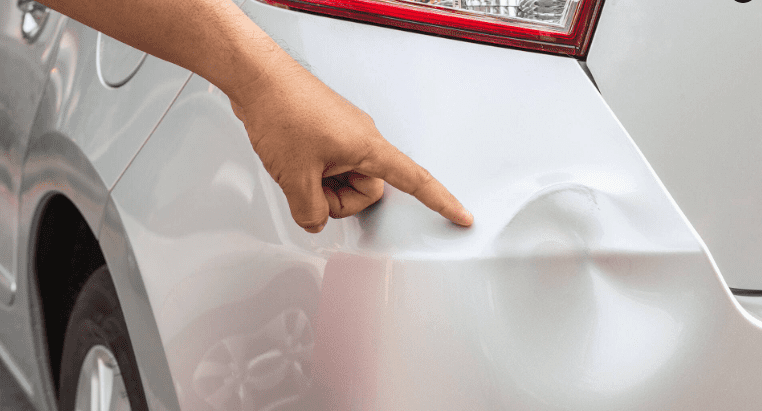Every vehicle owner has experienced that sinking feeling upon discovering an unsightly dent – whether it’s from a hailstorm, a minor collision, or an unfortunate encounter with a shopping cart.
The quest to restore a car’s flawless exterior can be daunting, often involving expensive visits to an auto body shop or hours spent researching DIY methods “remove dent with dry ice”. But what if there was a cost-effective and innovative solution hiding in plain sight? Enter dry ice – a substance known for its chilling effects but also celebrated for its potential to make dents disappear.
we will delve into the world of dent repair, focusing on the ingenious application of dry ice to revive your vehicle’s pristine surface. We’ll explore the intricacies of the process, debunk myths surrounding its effectiveness, and equip you with indispensable tips and tricks to master this DIY art. From understanding the science behind it to step-by-step instructions, we’re here to unravel the mystery behind dry ice dent removal.
As we journey through the realms of dents and dings, hail damage, paintless dent repair, and the art of precision, we’ll uncover how a simple sheet of dry ice can wield the power to transform your car’s panel. Whether you’re a seasoned DIY enthusiast or a curious car owner seeking an alternative to traditional repair methods, this article is your compass to navigate the world of dry ice dent removal. So, fasten your seatbelts, and let’s embark on a journey where cold meets dent, and innovation meets automotive revival.”
Step-by-Step Guide: Remove Dent with Dry Ice
Dents on your vehicle can be a frustrating eyesore but fear not – a creative and cost-effective solution lies at your fingertips. Dry ice, with its remarkable ability to contract metal upon cooling, offers a promising DIY method for dent removal. Follow these steps to effectively use dry ice to banish those unsightly dents from your car’s surface:
Note: Before proceeding to remove dent with dry ice, ensure you have proper protective gear, including gloves and safety goggles, as dry ice can cause frostbite if mishandled.
Step 1: Gather the Essentials
Collect the necessary items:
remove dent with dry ice: Obtain a block of dry ice from your local grocery store or supplier. Make sure to handle it with care and store it in an insulated container.
Gloves and safety goggles: Protect yourself from frostbite and potential debris.
Towels or cloths: These will act as a barrier between the dry ice and your car’s surface.
Step 2: Assess the Dent
Examine the dent to determine if it is suitable for dry ice dent removal. Shallow dents with no paint damage are ideal candidates. Large or complex dents may require professional assistance.

Step 3: Prepare the Area
Park your vehicle in a shaded area to prevent direct sunlight. Extreme temperature changes can affect the dent removal process. Clean the dent and its surrounding area to ensure there’s no dirt or debris that could interfere with the dry ice.
Step 4: Apply the Dry Ice
Wearing gloves, take a small piece of dry ice and wrap it in a towel. Gently rub the towel-wrapped dry ice over the dent for about 20-30 seconds. This rapid cooling will cause the metal to contract, potentially popping the dent back into place.
Step 5: Observe and Repeat
After applying the dry ice, carefully remove the towel and assess the dent. If it hasn’t fully popped out, you can repeat the process a few more times, giving the metal time to react to the temperature change. Be patient and avoid excessive force.
Step 6: Heating
If the dent doesn’t pop out after a few attempts with dry ice, you can try a combination approach. Use a hair dryer or heat gun to gently warm the dent for about 1-2 minutes. Then, quickly switch to the dry ice application. The rapid temperature change from hot to cold can encourage the dent to pop out.
Step 7: Evaluate the Results
Once the dent has popped out or significantly improved, carefully inspect the area. If the dent is still noticeable, you might need to repeat the process or consider seeking professional help.
Step 8: Finish and Polish
Once the remove dent with dry ice is completed to your satisfaction, clean the area and give your vehicle a thorough wash and wax to restore its shine.
Step 9: Safety First
Remember to prioritize safety throughout the process. Always wear protective gear during remove dent with dry ice.
Step 10: Know When to Seek Professional Help
If the dent is too deep, the paint is damaged, or you’re uncomfortable with the DIY process “remove dent with dry ice” , it’s wise to consult our professional auto body technician for proper dent repair.

The disadvantage of remove dent with dry ice
While using remove dent with dry ice can be a convenient and cost-effective DIY method, it’s important to be aware of its limitations and potential disadvantages. Here are some drawbacks to consider:
- Limited Effectiveness on Deep Dents: Dry ice is most effective on shallow dents where the metal can easily contract and pop back into place. Deeper dents may not respond well to this method, as the contraction of metal might not be sufficient to fully restore the dent.
- Risk of Overuse: Applying dry ice repeatedly or for an extended duration could potentially damage the car’s paint or even cause the metal to warp. This risk increases if the dry ice is mishandled or not used properly.
- Paint Damage: While dry ice itself is unlikely to damage the paint, the pressure exerted during the dent removal process might inadvertently cause the paint to crack or chip. This risk is particularly pronounced if the paint is already compromised.
- Inconsistent Results: The success of dry ice dent removal can vary based on factors such as the dent’s size, location, and the type of metal in the car. Achieving consistently satisfactory results requires a certain level of expertise and experience.
- Complex Dents Require Professional Help: For complex or unusually shaped dents, using dry ice may not be sufficient to achieve the desired outcome. In such cases, seeking professional help from an experienced auto body technician is often a better option.
- Safety Concerns: Working with dry ice presents potential hazards, such as frostbite or skin injury due to direct contact. Proper protective gear and handling procedures are essential to prevent accidents.
- Not Suitable for All Dent Types: Dry ice is generally effective for minor dents caused by factors like hail or small impacts. However, for larger or more severe damage, alternative repair methods may be more appropriate.
- Skill and Patience Required: Successfully using remove dent with dry ice requires a certain level of skill, patience, and precision. Novice users may not achieve optimal results, and the learning curve can be steep.
- Temporary Solution: While dry ice can provide a temporary fix for dents, it might not offer a permanent solution. Depending on the dent’s severity, it could pop back out over time or require further attention.
- Unknown Vehicle History: If you’re working with a used vehicle, you might not have full knowledge of the car’s previous repairs or alterations. Attempting a DIY dent removal method like dry ice without understanding the car’s history could lead to the unintended consequence
for proffesional dent repair
Does dry ice get dents out?
Yes, dry ice can be effective in getting certain types of dents out. When applied to the surface of a dent, dry ice’s extremely cold temperature can cause the metal to contract, potentially causing the dent to pop back into place.
This method is most successful for shallow dents without paint damage. However, for deeper or more complex dents, professional assistance may be required for optimal results. Always handle dry ice with care and prioritize safety when attempting dent removal.
Video for an explanation of the remove dent with dry ice
Conclusion for remove dent with dry ice
Dry ice can be a quick and inexpensive way to remove shallow dents from cars. However, it is important to be aware of the potential risks and disadvantages of this method before attempting it. Dry ice can damage the paint, is not always effective for deep dents, and can be messy. If you are unsure whether dry ice is the right method for you, it is best to contact our body shop.





